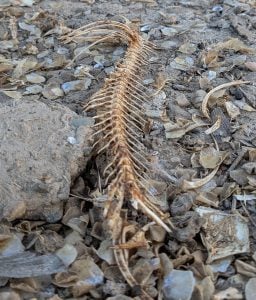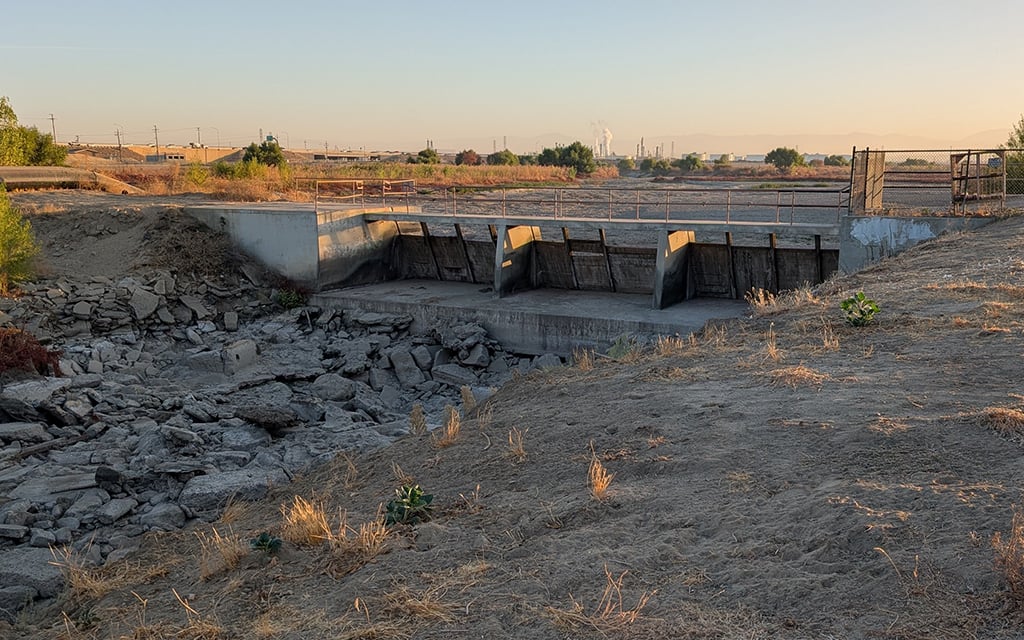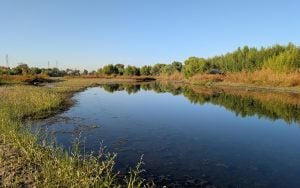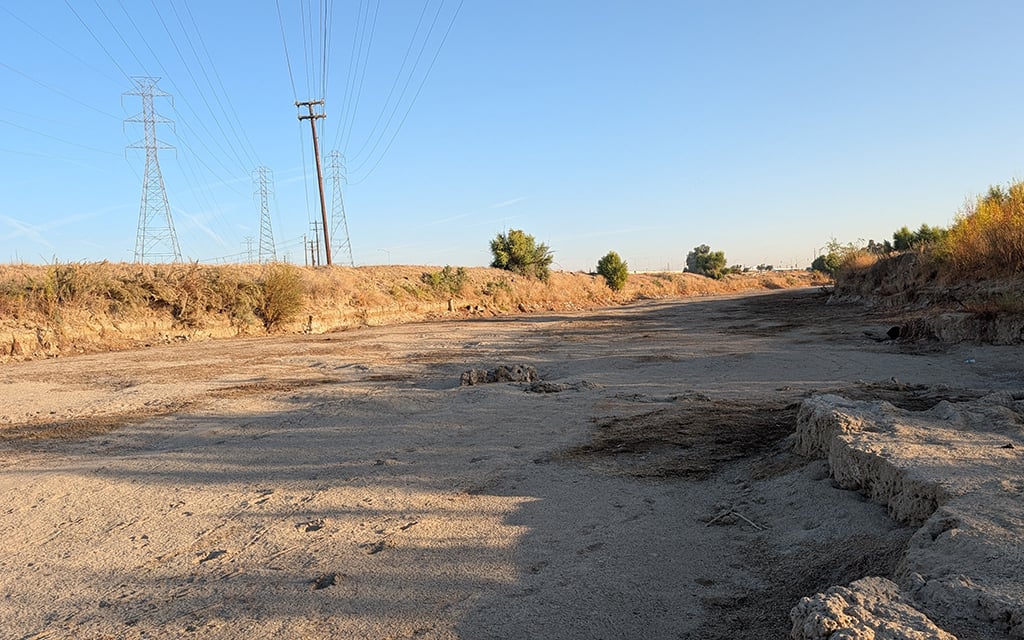LOS ANGELES – Thousands of dead fish have been left behind in the waterbed where the Kern River sometimes flows through Bakersfield – not due to drought but to maintenance by the city water department that added to accusations of mismanagement.
Those claims were brought to Superior Court in a 2022 lawsuit by multiple environmental advocacy organizations. In October, Bakersfield argued against the claims, asserting it is not solely responsible for the dewatering of the Kern River.
The recent fish deaths were “a really tragic situation, both ecologically and for the community, and of course for the wildlife because the fish has nowhere to go,” freshwater ecologist Rae McNeish said.
McNeish is an associate professor in the department of biology at California State University, Bakersfield, and over her five years in California, has seen the river at its highs and lows. She is not involved in the litigation.

Rae McNeish and her students have reported finding 3,000 dead fish. In addition to the native Sacramento suckers, they also have seen largemouth bass, channel catfish and bullheads, among many more species. Photo taken on Oct. 25, 2024, in the Bakersfield Environmental Study Area. (Photo by Rae McNeish)
“The river has mainly been a dry channel, except for the past, roughly, year and a half. … We had really good water years the past two springs,” McNeish said. “Everything changed near the river, and there was more people, there’s a lot more wildlife.”
Though the river has experienced dry spells, the recent dewatering is directly related to a weir maintenance project being done by the city of Bakersfield’s Water Resources Department. A weir is a dam used to raise water level or divert flow. The city said it needed to remove sediment buildup to improve flow.
According to a city news release, “Starting Tuesday, Sept. 3, the department will reduce river flows from Stockdale Highway River Bridge to the east to allow work areas to dry.” The department said maintenance at the Bellevue Weir was necessary to guarantee “safe and controlled” operation of the river.
“It would be great if those entities re-evaluated how they are dispersing the water so that the ecological integrity of the river could be maintained,” McNeish said.
Multiple California wildlife and conservation groups, including Bring Back the Kern, Center for Biological Diversity, the Sierra Club and others, are taking issue with the city and several other agencies in an ongoing lawsuit alleging poor decisions involving water diversion.
“The primary claims in this case, they all surround the city of Bakersfield’s management of six diversion dams or weirs that are in the river in city boundaries and are … owned and operated by the city,” said Adam Keats , a lawyer representing some plaintiffs in the lawsuit, in an interview earlier this month.
The lawsuit names four water storage districts and Kern County Water Agency as parties in interest.
He said two provisions in the California Fish and Game Code are being violated. Section 5901 prevents devices such as dams and weirs from impeding the ability of fish to swim upstream or downstream, and Section 5937 requires a dam owner to allow sufficient water flow to sustain life.
Bring Back the Kern and other groups say in the lawsuit the city’s management of the Kern River’s water flow does not comply with these requirements.

The River Canal Weir is located east of Coffee Road bridge. The city of Bakersfield is currently seeking bids for reconstruction following damage from high water flows in 2019 and 2023. Photo taken on Oct. 25, 2024, in the Bakersfield Environmental Study Area. (Photo by Rae McNeish)
“All six dams operate at different points in different stages to completely dewater the river,” Keats said. “Some of them are worse offenders than others at different times, but all of them dewater the river at different times, so all of them are problematic that way.”
According to the complaint, the city of Bakersfield is a stand-alone defendant while several water storage districts and a county agency are listed as parties in interest. On Oct. 28, the city responded that it is just one of multiple entities that divert and use water, and the parties in interest should also be listed as defendants.
“Environmental Respondents’ choice to focus all of their claims against Bakersfield makes complete relief on the Kern River, and sustained and regular increased flows, a practical impossibility,” the city said in its 5th District Court of Appeal answer, contending the parties in interest “divert the vast majority of water out of the lower Kern River.”
The parties in interest, which include Buena Vista, Kern Delta, North Kern, Rosedale-Rio Bravo water districts and Kern County Water Agency, were contacted but either declined to comment or did not respond.
The city of Bakersfield argued that it would be dangerous and irresponsible to prioritize the needs of fish over the drinking water needs of Bakersfield residents.
“Legally, practically and as a matter of common sense, fish flows called for under Fish and Game Code Section 5937 cannot take priority and precedence over water for people,” the city said in its answer.
In addition to the Fish and Game codes concerned, the complaint outlines a potential violation under the public trust doctrine, which protects natural resources for public use. The city agreed to uphold this doctrine when it bought rights to the river in 1976.

The McNeish Lab is now studying new river sites in addition to the now-dry river sections it previously surveyed. Photo taken on Oct. 25, 2024, upstream from the Bakersfield Environmental Study Area. (Photo by Rae McNeish)
“The city can’t harm these resources without considering the impacts of its actions,” Keats said. Bakersfield “hasn’t taken obviously feasible measures that could either avoid or minimize the harm that’s being done to the trust resource.”
The city told the court of appeals that plaintiffs failed to acknowledge its efforts to return the river to vibrancy.
And it sought to deflect blame to the state, in particular the California State Water Resources Control Board, accusing the state of withholding water that would keep the Kern flowing through Bakersfield.
“The State should be well aware of Bakersfield’s ongoing, long-time efforts to increase flows of water in the Kern River,” the city said.
Bakersfield said it had made “decades of repeated attempts” to persuade the state to release up to 50,000 acre-feet per year (afy) of unappropriated water to increase river flows.
“Bakersfield would be happy to continue to work with the State to increase Kern River flows, the city argued in its court filing.
The court case began in 2022 and is ongoing.
McNeish had been bringing students to the river since summer to collect baseline data for future research on the river as a part of the McNeish Lab, which focuses on aquatic ecology research. They are now working to expand their research to other, wet parts of the river.
“Kern River is an important ecological resource in the landscape, and it is an important resource for the citizens of the city and the surrounding region,” McNeish said. “In a perfect world, all of these demands would be able to be met for both the citizens and city needs … while maintaining the ecological integrity of the river, too.”

